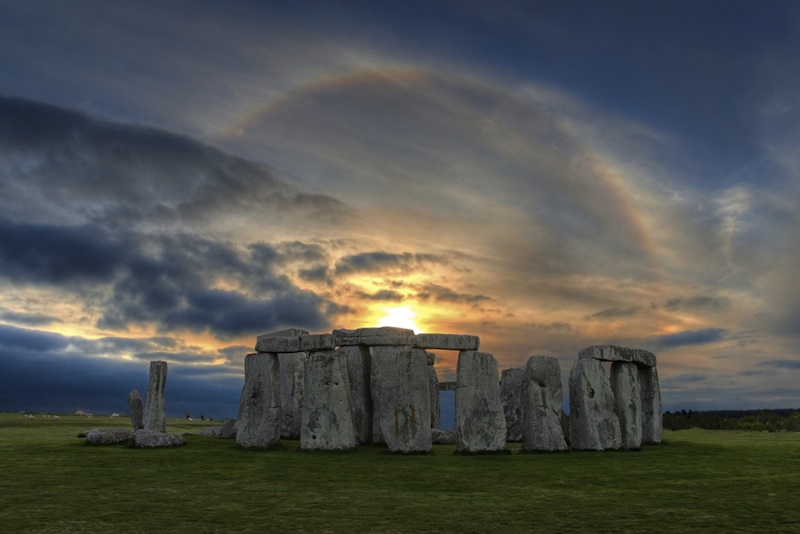5 Strange Theories About Stonehenge

Thousands of years ago, an ancient civilization raised a circle of huge, roughly rectangular stones in a field in what is now Wiltshire, England. Stonehenge, as it would come to be called, has been a mystery ever since.
Building began on the site around 3100 B.C. and continued in phases up until about 1600 B.C. The people who constructed the site left no written records and few clues as to why they bothered to schlep the stones to this spot.
Wild theories about Stonehenge have persisted since the Middle Ages, with 12th-century myths crediting the wizard Merlin with constructing the site. More recently, UFO believers have spun theories about ancient aliens and spacecraft landing pads.
But Stonehenge has inspired a fair number of scientifically reasonable theories as well. Here are five major (and not necessarily mutually exclusive) reasons Stonehenge might exist. [Gallery: Stunning Photos of Stonehenge]
1. A place for burial
Stonehenge may have originally been a cemetery for the elite, according to a new study. Bone fragments were first exhumed from the Stonehenge site more than a century ago, but archaeologists at the time thought the remains were unimportant and reburied them. Now, British researchers have re-exhumed more than 50,000 cremated bone fragments from where they were discarded, representing 63 separate individuals, from Stonehenge. Their analysis, presented on a BBC 4 documentary on March 10, reveals that the people buried at the site were men and women in equal proportions, with some children as well.
The burials occurred in about 3000 B.C., according to study researcher Mike Parker Pearson of the University College London Institute of Archaeology, and the very first stones were brought from Wales at that time to mark the graves. The archaeologists also found a mace head and a bowl possibly used to burn incense, suggesting the people buried in the graves may have been religious or political elite, according to The Guardian newspaper.
Sign up for the Live Science daily newsletter now
Get the world’s most fascinating discoveries delivered straight to your inbox.
2. A place for healing
Another theory suggests that Stone Age people saw Stonehenge as a place with healing properties. In 2008, archaeologists Geoggrey Wainwright and Timothy Darvill reported that a large number of skeletons recovered from around Stonehenge showed signs of illness or injury. The archaeologists also reported discovering fragments of the Stonehenge bluestones — the first stones erected at the site — that had been chipped away by ancient people, perhaps to use as talismans for protective or healing purposes.
3. A soundscape
Or perhaps Stonehenge's circular construction was created to mimic a sound illusion. That's the theory of Steven Waller, a researcher in archaeoacoustics. Waller says that if two pipers were to play their instruments in a field, a listener would notice a strange effect. In certain spots, the sound waves from the dual pipes would cancel each other out, creating quiet spots.
The stones of Stonehenge create a similar effect, except with stones, rather than competing sound waves, blocking sound, Waller reported in 2012 at the annual meeting of the American Association for the Advancement of Science. Legends associated with Stonehenge also reference pipers, Waller said, and prehistoric circles are traditionally known as "piper stones."
Waller's theory is speculative, but other researchers have confirmed that Stonehenge had amazing acoustics. A study released in May 2012 found that the circle would have caused sound reverberations similar to those in a modern-day cathedral or concert hall.
4. A celestial observatory
No matter why it was built, Stonehenge may have been constructed with the sun in mind. One avenue connecting the monument with the nearby River Aven aligns with the sun on the winter solstice; archaeological evidence reveals that pigs were slaughtered at Stonehenge in December and January, suggesting possible celebrations or rituals at the monument around the winter solstice. The site also faces the summer solstice sunrise, and both summer and winter solstices are still celebrated there today. [Gallery: Stunning Summer Solstice Photos]
5. A team-building exercise
Or perhaps Stonehenge was something like an ancient team-building exercise. According to the University College London's Pearson, the beginning of the site's construction coincides with a time of increased unity among the Neolithic people of Britain. Perhaps inspired by the natural flow of the landscape, which seems to connect summer solstice sunrise and winter solstice sunset, these ancient people may have banded together to build the monument, Pearson suggested in June 2012.
"Stonehenge itself was a massive undertaking, requiring the labor of thousands to move stones from as far away as west Wales, shaping them and erecting them," he said in a statement. "Just the work itself, requiring everything literally to pull together, would have been an act of unification."
Follow Stephanie Pappas @sipappas. Follow LiveScience on Twitter @livescience, Facebook or Google+. Original article on LiveScience.com.

Stephanie Pappas is a contributing writer for Live Science, covering topics ranging from geoscience to archaeology to the human brain and behavior. She was previously a senior writer for Live Science but is now a freelancer based in Denver, Colorado, and regularly contributes to Scientific American and The Monitor, the monthly magazine of the American Psychological Association. Stephanie received a bachelor's degree in psychology from the University of South Carolina and a graduate certificate in science communication from the University of California, Santa Cruz.









